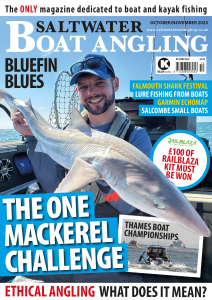With more and more big bass being landed Wayne Comben gives some tips on catching monster.
For many boat anglers landing a double figure bass is top of their wish list. These superbly formed predators these handsome fish are masters of their environment; ambush pack hunters that hit prey fast and hard.
Targeting locations
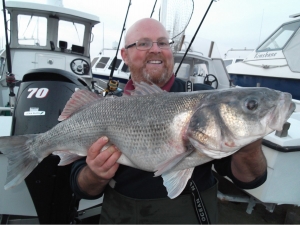 When targeting double figure fish the first thing to do is locate the bait that bass feed on. That can mean many different types of prey and in different areas; Wrecks, reefs and in particular banks in fast currents are key places, anywhere that creates a rip where bait fish struggle with the current is likely to see bass hunting. Put simply, bass feed with the tides. Depending on how a structure lies there will be a stage of the tide where, as the flow picks up, it creates turbulence. Many spots will only do this if the tide is flowing hard and most will be either ebb or flood dependant. This makes sense when you realise one area may have the perfect hunting conditions on a strong ebb tide, and be completely unsuitable on a weaker flood, and often bass will only be there feeding for that short period of time. This means not only finding the right area but being there exactly when the fish are. To do this can do a little exploratory work. In my experience, once a likely spot has been found it needs to be tried at all stages of a tide. This can mean blank drift after blank drift until, hopefully, you finally hit into them. But if you have the patience the rewards can be more than worth the effort.
When targeting double figure fish the first thing to do is locate the bait that bass feed on. That can mean many different types of prey and in different areas; Wrecks, reefs and in particular banks in fast currents are key places, anywhere that creates a rip where bait fish struggle with the current is likely to see bass hunting. Put simply, bass feed with the tides. Depending on how a structure lies there will be a stage of the tide where, as the flow picks up, it creates turbulence. Many spots will only do this if the tide is flowing hard and most will be either ebb or flood dependant. This makes sense when you realise one area may have the perfect hunting conditions on a strong ebb tide, and be completely unsuitable on a weaker flood, and often bass will only be there feeding for that short period of time. This means not only finding the right area but being there exactly when the fish are. To do this can do a little exploratory work. In my experience, once a likely spot has been found it needs to be tried at all stages of a tide. This can mean blank drift after blank drift until, hopefully, you finally hit into them. But if you have the patience the rewards can be more than worth the effort.
Often bass can be seen on the sounder, although not always, so do not be put off trying a spot just because nothing is showing up on screen. Most bass will be feeding near the bottom but this is not always the case. On occasions they will be feeding slightly higher in the water column depending on where the prey is so it can be a good idea to work a bait through the water column to find where that hit zone is.
Techniques and tackle
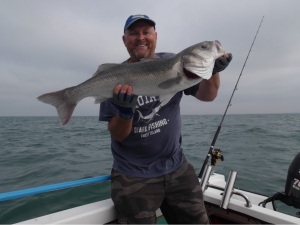 By far the most productive technique when targeting bass is drift fishing. You can generally go fairly light. Rods in a 12lb class or similar are ideal and reels can be fixed spool or multiplier depending on preference. An in-line bead which has a small strong swivel attached is all that is needed to carry the weight. A five-or-six-foot trace of 20lb to 25lb fluorocarbon finishing with a strong 2/0 hook works well. This set up can be fished with lures, live or dead baits. The main thing is to keep everything simple and to a minimum. Do not be tempted to over embellish a rig.
By far the most productive technique when targeting bass is drift fishing. You can generally go fairly light. Rods in a 12lb class or similar are ideal and reels can be fixed spool or multiplier depending on preference. An in-line bead which has a small strong swivel attached is all that is needed to carry the weight. A five-or-six-foot trace of 20lb to 25lb fluorocarbon finishing with a strong 2/0 hook works well. This set up can be fished with lures, live or dead baits. The main thing is to keep everything simple and to a minimum. Do not be tempted to over embellish a rig.
The drift
Once a likely spot has been found start your drift a good few hundred yards up-tide and take a measured drop to the sea bed. Depending on the depth and strength of the tide you will need a weight just heavy enough to take your bait or lure down. It is not good practice to go too heavy. Remember, just enough weight and no more than is necessary is key.
Any more than required only adds an unnatural look to the presentation. Once you hit the bottom take a turn or two and keep in contact with the sea bed by bumping the weight occasionally depending on the nature of the bottom. Getting this wrong can result in tackle loss, especially if the ground is broken but it’s important since most bass will be likely very near the bottom.
Live-bait is best
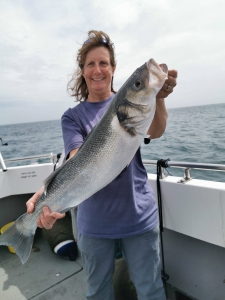 In reality, nothing quite beats a livebait. If you can catch what the bass are naturally feeding on, and present it in that form, then you will catch fish. That being said, when a bass shoal is feeding hard the fish compete – this is the golden time. This is when the bigger fish can be picked out using the right tactics. Keeping the rig simple is the key and often the size of the bait will dictate the size of the fish that hits it. While fish generally, and bass in particular, hit baits far bigger than realistically targetable, if you persist with a big bait you will up your chances of a sizeable fish. This may seem obvious but in practice a smaller bait/lure will probably see more fish hooked but the general size will be smaller also. That is not to say a big bass won’t take a small bait but if you hedge your bets a double is more likely if the offering matches the fish you wish to target.
In reality, nothing quite beats a livebait. If you can catch what the bass are naturally feeding on, and present it in that form, then you will catch fish. That being said, when a bass shoal is feeding hard the fish compete – this is the golden time. This is when the bigger fish can be picked out using the right tactics. Keeping the rig simple is the key and often the size of the bait will dictate the size of the fish that hits it. While fish generally, and bass in particular, hit baits far bigger than realistically targetable, if you persist with a big bait you will up your chances of a sizeable fish. This may seem obvious but in practice a smaller bait/lure will probably see more fish hooked but the general size will be smaller also. That is not to say a big bass won’t take a small bait but if you hedge your bets a double is more likely if the offering matches the fish you wish to target.
One other thing I have noticed is some of the bigger fish tend to patrol the outskirts of a shoal. By setting the drift on the edge of the main mass on a sounder I have definitely picked up some better specimens. [breakout quote]
Winter bass
On the south coast bass can be caught virtually all year round, although May through to October is when the most productive locations tend to fish the best. Once winter approaches things tend to change a little. This is a time when big solitary fish will often cruise open ground in search of an easy meal. Many anglers fishing for big winter cod will have picked up a bass now and again, but there are a few tips that will help you locate them with a little more precision.
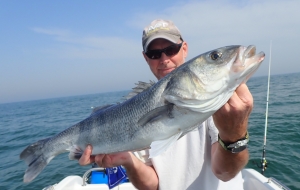 Winter bass are a totally different proposition to the summer forms. If you want to pick out a big bass while winter anchor fishing then there is one thing that will increase your chances more than most. Take an outfit with you that can cast a reasonable distance. Once you are settled into a day’s fishing at anchor and your normal baits have been deployed take a suitable bait – by that I mean anything you can cast as far down tide as possible. Heave it as far as you can. Whatever you are using for the day, be it squid, cuttle or worm, if it can be cast down-tide. Then put it out as far as you can. Once it has settled on the bottom give it five minutes, disengage the spool, lift the rod and let the bait move and settle down-tide again. Repeat this until you feel the bait has gone back as far as you dare and reel in and repeat. This technique has picked out more bass than any other while at anchor and if you have the ability to be proactive rather than sit back and watch static baits I can assure you it is definitely worth doing.
Winter bass are a totally different proposition to the summer forms. If you want to pick out a big bass while winter anchor fishing then there is one thing that will increase your chances more than most. Take an outfit with you that can cast a reasonable distance. Once you are settled into a day’s fishing at anchor and your normal baits have been deployed take a suitable bait – by that I mean anything you can cast as far down tide as possible. Heave it as far as you can. Whatever you are using for the day, be it squid, cuttle or worm, if it can be cast down-tide. Then put it out as far as you can. Once it has settled on the bottom give it five minutes, disengage the spool, lift the rod and let the bait move and settle down-tide again. Repeat this until you feel the bait has gone back as far as you dare and reel in and repeat. This technique has picked out more bass than any other while at anchor and if you have the ability to be proactive rather than sit back and watch static baits I can assure you it is definitely worth doing.
Bass regulations
It is worth mentioning bass regulations at this point. Make sure you check how they stand at the time of fishing. If you are lucky enough to hit into that fish of a lifetime you do not want to fall foul of the rules. At the moment we can only land one fish, per angler, per trip but this may change in 2020 so keep an eye out for the latest news on this.
